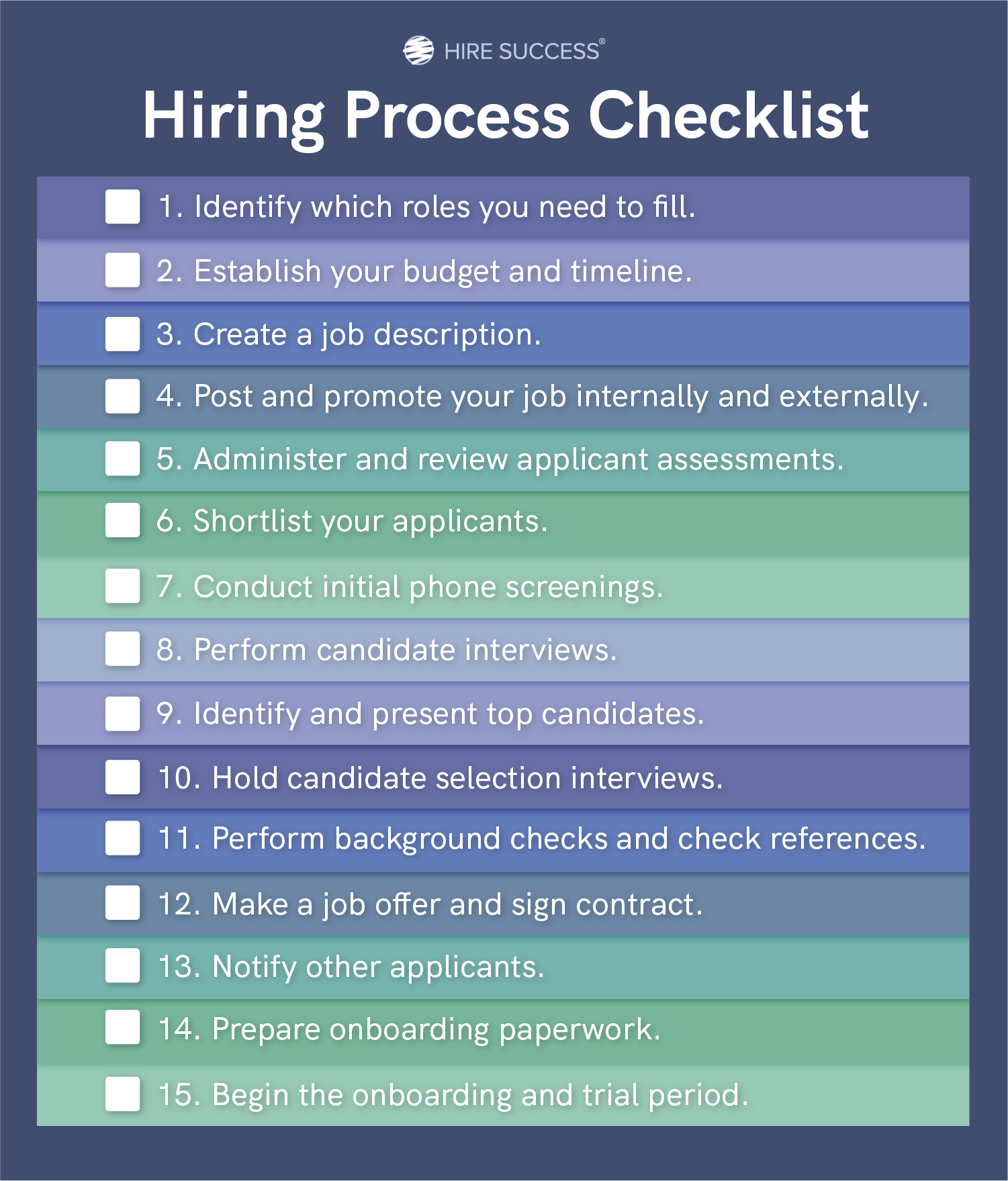The hiring process has entered a new era. In today’s competitive job market, speed and a tech-savvy strategy give you the edge in finding the best talent. At a time of skill shortages, low unemployment, and the rapid rise of AI usage, by both employers and candidates, the whole hiring process is changing quickly. Making your hiring process more efficient and engaging will improve your ability to source and screen candidates.
This hiring process checklist will help you examine every step of your current approach, so you can find ways to use data and automation to dramatically reduce your time-to-hire while improving the quality and on-the-job performance of the people you add to your team.
Key takeaways
- Hiring is hypercompetitive due to low unemployment, a growing skills gap, and advancing technology.
- Developing a standardized hiring process creates a great candidate experience and increases your chances of securing top talent.
- Data-based technology, such as pre-employment testing, can help you screen applicants to quickly identify the right candidates.
- Making fast and objective hiring decisions is essential when competing for great employees in today's job market.
What should a standard hiring process include?
The general outline of the hiring process starts with planning the workforce and describing the specific roles needed. Setting up required skills and defining success by role is an important part of this step.
The process continues with sourcing candidates, then communicating openings through job boards, referral networks, social media, and more. Applicants must then be screened and assessed, which can include reviewing resumes, making screening phone calls, and using skills tests to identify the most promising talent.
Next comes conducting interviews, ideally using a mix of structured and unstructured approaches. The final step in the process is to make a selection, extend an offer, and ultimately begin onboarding the new hire.
Why do you need guidelines for hiring?
Having a clear roadmap of your hiring process improves your ability to attract high-quality candidates, then evaluate, hire, and onboard the best people. Up-to-date hiring guidelines are especially valuable when skilled candidates are hard to find and technology is upending traditional approaches. Guidelines ensure that all hiring managers and recruiters are aligned around a standardized and well-thought-out process.
It’s vital to ask the right questions and consistently apply the same criteria to create a process that’s as fair as it is effective. You’ll have a process that delivers a positive candidate experience while finding qualified talent and making the right choices in less time. Not only will you lower costs throughout the process, but you will also avoid the cost of a bad hire.
A quick hiring checklist to download

We’ve created this simple hiring process checklist that covers every critical step, from planning to onboarding. Having a standardized checklist speeds your time-to-fill and keeps your teams aligned. Feel free to copy-and-paste or download the checklist as a PDF below. You can also use this as a starting point for creating your own personalized checklist.
Identifying a vacant role and planning:- Identify which roles you need to fill
- Establish your hiring budget and timeline
- Create or update a job description
- Build an ideal candidate profile
- Post your job internally and externally
- Promote the job and your brand
- Administer and review applicant assessments
- Shortlist qualified job applicants
- Conduct initial phone or video screenings
- Perform candidate interviews
- Identify and present top candidates
- Hold candidate selection interviews
- Select the final candidate
- Check references and background
- Make the job offer
- Notify unsuccessful candidates
- Sign a contract with a new employee
- Prepare onboarding paperwork
- Onboard the new hire
- Schedule regular check-ins for feedback and support
Your checklist should be finalized before you need to hire. This helps you determine which personality traits and characteristics are most critical ahead of time, then keep them top of mind throughout the interviewing and onboarding process. Find a more detailed step-by-step guide to hiring below.
15-step guide for employers

With a hiring process that is clear and standardized for everyone, you can spot top talent more quickly, reducing the money and effort it takes to find the right person to hire. You will also create a great candidate experience and improve the success of your choices while avoiding bad hires.
Step 1: Identify which roles you need to fill
To make a strong impact, whether replacing a team member or expanding teams, focus your hiring on the exact roles you need. While you may have some notice before you need to hire, hiring needs tend to pop up unexpectedly. You have to move quickly. Solid planning in advance gives you the agility to handle the unexpected more smoothly. Here are some tips for thinking through your needs and priorities:
- Review org charts, project plans, and employee reviews for an idea of potential departures, promotions, and the need for new hires to cover expansion.
- Clarify details around each role, including its objectives, success criteria, and whether the opening is a replacement or a new role.
- Gather team insights, meeting with direct managers and the team around each role to understand workload issues, gaps, and future growth opportunities.
Step 2: Establish your budget and timeline
Set a recruiting budget and timeline for each role to avoid surprises or falling behind schedule. Planning around costs and important milestones speeds the process and keeps everyone aligned. Try doing the following:
- Set the salary range using market data to offer a competitive pay and compensation package.
- Consider extra costs, such as signing bonuses, relocation and equipment reimbursements, and training expenses.
- Benchmark skills and traits for a candidate success profile that you can use to find candidates who match with standards likely to indicate high performers.
- Set up your hiring timeline with target dates for publicizing the opening, screening candidates, scheduling interviews, and making an offer.
- Allow some buffer in the schedule for unavoidable delays, and adjust timelines and budgets to refine the process for the next time.
Step 3: Create a job description
The job description is the first impression you make on a candidate. It should clearly explain what the role involves, specify desired skills and experience, and convey why someone would want to join your team.
An effective job description serves two purposes: it attracts qualified applicants and sets expectations as to performance and potential fit. You want the right people to see themselves in the role.
Here are tips for creating a good job description:
- Use a clear title that contains words and phrases a candidate may search for.
- Avoid jargon and fluff.
- Summarize the role and its impact on the organization.
- List out day-to-day duties, project contributions, and core responsibilities.
- Show where the role fits into the organization and who the potential employee will report to.
- Specify necessary qualifications, essential skills and certifications, and nice-to-have bonus characteristics.
- Describe company values, the work environment, and benefits that make the role stand out.
- Use parts of the success profile to describe the traits and work styles that will contribute to success in the role.
- Write with search engines in mind to make your job opening easily findable.
- Take care with language to ensure you appeal to a diverse pool of applicants and that you do not introduce bias into the process.
Move beyond resumes, identify true potential
Make smarter hiring decisions using objective data on candidates' strengths, work styles, and personality traits.
Book a Demo Try It FreeStep 4: Post and promote your job internally and externally
Make sure qualified candidates see your job opening and believe that the role and your organization are appealing. Write your job ad in a way that frames the skills and qualifications in terms of how potential employees can make a difference, and include the salary range and benefits package.
You need to sell the company, too, by talking about its values, culture, and larger purpose. Promote opportunities internally, as your best candidate might already work for you. Recruiting from outside at the same time may bring fresh perspectives and new skills.
Some tips for promoting an opening include:
- Share the opening internally first, using newsletters, the intranet, and team meetings. You can promote from within and also make use of employee networks.
- Create an employee referral program that incentivizes people to recommend good talent that is most likely to fit into the culture.
- Update and enrich your website career page. All too often, old jobs are left up long after they are filled. Add videos, testimonials, and cultural content.
- Post on job boards like LinkedIn, Indeed, and platforms that are niche to your industry.
Step 5: Administer and review applicant assessments
Clear planning helps you quickly attract and assess top talent. With effective screening, you will be able to focus on the strongest candidates for further evaluation. This means you should:
- Assess the must-have competencies first to focus on the skills and traits that matter the most.
- Use pre-employment testing from a vetted platform to objectively screen candidates with the skills and cognitive abilities to succeed in the role.
- Don’t just test for skills. Consider personality testing for a good cultural fit.
- Give candidates information about the hiring process, testing, and milestones so they can track where they are in the process.
- Treat candidates with respect, offering accommodation where needed and providing timely feedback to build goodwill and keep the people you want engaged.
Step 6: Shortlist your applicants
Pre-employment testing helps you quickly sort through candidates to create an applicant shortlist. Focus on potential hires likely to be strong performers. Aim for 5-7 candidates for an efficient interview process. In addition:
- Use assessment scores to rank candidates by each skill and trait in your success profile.
- Take a second look at the resumes of top scorers to see if they have relevant experience and skills.
- Look at bonus areas for characteristics that set the best candidates apart.
- Invite the shortlisted candidates for interviews right away and let them know the next steps and timing.
Step 7: Conduct initial phone screenings
When scheduling meetings, add a quick phone screen to ensure candidates are still available, verify qualifications, and address any resume gaps. It is a great opportunity to talk about the company culture and the value of joining the team. Other tips include:
- Script these calls in advance so that you cover all the key points and get answers to open questions.
- Confirm qualifications, skills, certifications, and experiences that are vital to the role.
- Probe for explanations of irregularities in the resume.
- Talk up your company, the role, and the culture.
- Listen to the candidate, noting their clarity, professionalism, and enthusiasm level.
- Review the process, next steps, and timeline for making a decision.
Step 8: Perform candidate interviews
Interviewing top candidates is a matter of asking the right questions, then listening carefully and observing the candidate. Interviewing is a skill. You’ll want to avoid potential pitfalls and watch out for red flags, rehearsed answers, and signs of deception. Following best practices for conducting better interviews can help you stay on track. And taking great notes is also key.
Here are some things to keep in mind:
- Plan your questions, mixing structured and unstructured interview styles.
- Consider your environment. In person, a quiet and well-lit space helps. Online, you want a clutter-free background and a camera, mic, and internet connection that work well.
- Body language can tell you as much as verbal answers.
- Having an interview checklist and scoring rubric can help you assess the answers and objectively compare candidates.
- Give candidates a chance to ask their own questions, which demonstrates their knowledge and interest in a role.
Step 9: Identify and present top candidates
Now comes the hard part: reviewing your notes, scoring responses, and weighing each candidate. Perhaps there is something unique in their background, or they shared a fresh perspective. Maybe they have a skill that might elevate your team.
Tips for evaluating candidates include:
- Compare each candidate against success profiles for the best matches.
- Highlight skills, achievements, and qualifications that set certain candidates apart.
- Create a scoring matrix to make assessing candidates visually easier and to make the process as objective as possible.
- Discuss the short list with the team to capture observations and viewpoints that can help you make a decision.
Step 10: Hold candidate selection interviews
Formalizing the selection process can help you find the best person for the job. A hiring panel that includes someone from HR, a team member, the hiring manager, and the initial interviewer gives you the opportunity to pool perspectives for a more confident and well-rounded decision.
Things to keep in mind are:
- Gather the right panel to capture varied viewpoints.
- Use a structured interview format to evaluate the candidates and review their scores and answers.
- Make sure everyone is involved and has their say. Encourage open dialogue.
- Invite contrary opinions to avoid groupthink. Don’t rush to settle on one candidate too quickly. Give them all a fair and full evaluation.
- Document the process for the next time and in order to maintain records if your company needs to prove compliance with regulations and company policies.
Step 11: Perform background checks and check references
Do a last check on your top pick and at least one runner-up. You need to verify their backgrounds, check references, and confirm qualifications. Screen for criminal records, credit issues, and any red flags on social media.
Consider the following:
- Get written consent to conduct background checks to stay compliant with privacy laws.
- Verify education, past employment, and certifications.
- You will want to uncover criminal backgrounds and credit issues, as well as social media posts. A reputable background-screening vendor can ensure you get complete, accurate, and compliant reports quickly.
- Use reference calls to assess candidate qualifications, work style, and personality, uncovering any issues that fall short of the criminal, but may be red flags.
- Document everything to be safe.
Step 12: Make a job offer and sign a contract
Making the offer is rewarding for you and the potential new hire. Top candidates often have more than one opportunity to consider, so you want to make yours stand out. You may need to negotiate, so keep in mind:
- Your letter should be enthusiastic, welcoming, and forward-looking.
- Be clear about the pay package, bonus, benefits, and perks like flex scheduling, professional development opportunities, stipends, and more.
- Know the likely negotiation points and what is possible on your side, so you can respond quickly.
- Give the candidate a reasonable deadline to accept your offer.
- Provide a formal employment agreement that covers responsibilities and expectations, a probation period, and termination clauses.
- Include a welcome guide that outlines onboarding and further sells the company.
Step 13: Notify other applicants
You may want to later hire unselected candidates for a future role. Or they may refer you to qualified people. You always want to leave a positive and professional impression that shows candidates respect and keeps them on your radar for the future. To that end:
- Send rejections promptly and make them personal. Thank candidates for their interest and provide a short reason why you chose someone else.
- In some cases, it is valuable to provide constructive feedback about areas to strengthen for the future.
- Invite them to stay connected and to apply to other opportunities.
Step 14: Prepare onboarding paperwork
Getting off to a strong start improves the chance that a hire will be successful. It also establishes your company as being squared away and professional. Tips to keep in mind include:
- Set up all the necessary paperwork, including tax forms, direct deposit enrollment, sharing emergency contacts, getting IDs and access cards, and issuing equipment.
- Use digital tools and online portals to minimize the paper in the process.
- Assign a point person to handle these details.
Step 15: Begin the onboarding and trial period
Set up new hires for success from the first day. Take the time to plan their arrival so that there is someone to show them around, introduce them to colleagues, and make sure that they get to the right workspace and have the tools they need.
Check in regularly during the first six months. The time you invest upfront will pay off in productivity, engagement, and a long-term commitment to your company. Consider the following actions:
- Structure the first days and weeks with a roadmap of activities, tasks, goals, and check-ins.
- Formally introduce them to the people who matter and provide a tour of the facility.
- Assign a mentor or colleague as someone they can go to with questions about team dynamics and company details.
- Offer training courses, shadowing opportunities, and other professional development activities.
Hire Success® helps you make fast hiring decisions
Hire Success® recruitment tools and services are designed to help you improve your hiring process. Using data-driven insights, they help you develop job success profiles and identify the best potential candidates, then provide effective interview questions to ensure you’re making the right choice.
With a robust hiring process checklist in place and data analysis to inform your choices, you’ll hit the ground running when you need to fill a vacancy.


